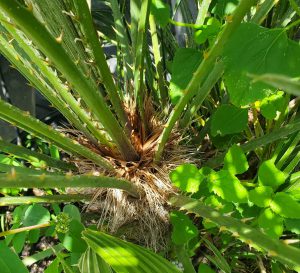
The first thing that you may ask is are there really palms native to Europe? Then, can this palm from a non-tropical area live in Florida? Well, the answer is “yes” to both! The European fan palm (Chamaerops humilis) is native to southwest Europe including parts of Spain, Portugal, Italy, France and other areas on the Mediterranean. This area of the world is going to almost guarantee that this palm species is drought tolerant. Is there a European fan palm in your future?
The European fan palm has many attributes to unpack. First, as mentioned, it is drought-tolerant with medium salt-tolerance. It is also extremely cold-tolerant with minimums in the 10-degree zone – not a problem here! Listed as a Florida-Friendly Landscaping™ approved plant, this slow-growing palm is rarely seen in the local landscapes. There are a few around, but their very slow growth may test gardeners’ patience. This slow growth may be a benefit in many sites needing smaller and more easily sustained palms. While this clumping fan palm can reach heights of fifteen feet tall and ten foot wide, locally expect eight-foot tall and six-foot wide over many years. The European fan palm is noted as having fifteen-inch palmate fronds armed with teeth. These “teeth” bring with them a caution as to where to plant in regard to reduce bloodletting to passersby and pets. Full-sun planting sites are preferred, and compact growth will be realized in these environmental conditions. Partial shade can be tolerated and will result in larger fronds, but slower growth.
The literature indicates that there are several cultivars that may be available. One called ‘Vulcano’ is very compact and thornless. A variety named Blue Mediterranean (European) fan palm is also available on the market featuring silvery blue foliage. Locally, some garden centers do carry the common species European fan palm, Chamaerops humilis.
The European fan palm is underplanted in our area. The largest one I saw several years ago was about five-feet tall and looking great. And then, someone over-pruned it which really took the ornamental appeal away. I went looking for it the other day and it is now gone. Specimens available locally will likely be pricey as this palm is so slow growing. However, a specimen European fan palm can make a great centerpiece in small gardens which will catch observers’ eyes as they ponder what type of palm it is and covet yours! For more information on all types of palms suitable for our area, you can also call the Master Gardener Volunteer Helpdesk on Mondays, Wednesdays and Fridays from 1 to 4 pm at 764-4340 for gardening help and insight into their role as an Extension volunteer. Ralph E. Mitchell is the Director/Horticulture Agent for UF/IFAS Extension – Charlotte County. He can be reached at 941-764-4344 or ralph.mitchell@charlottecountyfl.gov . Connect with us on social media. Like us on Facebook @CharlotteCountyExtension and follow us on Instagram @ifascharco.
Resources:
Beckford, M. (2022) Foolproof Palm Care: European Fan Palm. The University of Florida Extension Service, IFAS.
Warner, K. (2017) Fact sheet: European Fan Palm. The University of Florida Extension Service, IFAS.
The Florida-Friendly Landscaping™ Guide to Plant Selection & Landscape Design (2010) The University of Florida Extension Services, IFAS.
Chamaerops humilis Common Name(s): European Fan Palm – Mediterranean Fan Palm. (2023) N.C. Cooperative Extension
UF/IFAS Gardening Solutions (2019) European Fan Palm. The University of Florida Extension Service, IFAS.
 1
1
